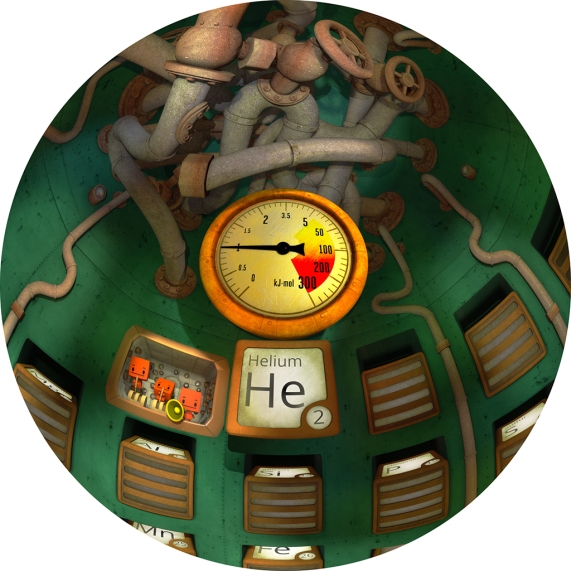Scientists like to categorise things. “This is how the universe began,” they say, or, “This is how atoms work,” or, “Here’s how humans developed from their apelike ancestors.”
But science isn’t just studying the individual dots. It’s working out how they join up. Because everything is connected. After all, that’s what the word “universe” really means: turned into one.
This connectivity is the theme of We Are Stars, a new fulldome science documentary from award-winning computer animation studio NSC Creative which enjoyed its official world premiere last night, 15 July 2015, at the National Space Centre, Leicester, UK.

Choosing as its subject nothing less than the entire history of creation, the 26-minute steampunk-themed film boldly goes on a dizzying journey through time from the Big Bang to the present day. Beginning with the simplest atoms, We Are Stars explains how nuclear fusion in the hearts of early stars allowed the construction of more complex elements, which were then sprayed across space by vast supernova explosions, creating giant nebulae which then condensed to form new stars surrounded by planets laced with those complex elements, which in turn became the building blocks of primitive life, which gradually evolved into, well, us.
 Sounds complicated? Fear not – the carefully-researched science in We Are Stars is delivered with effortless panache by the Time Master, a Victorian tour guide who chaperones both his animated acolytes and their real human audience on this eye-opening odyssey through space and time.
Sounds complicated? Fear not – the carefully-researched science in We Are Stars is delivered with effortless panache by the Time Master, a Victorian tour guide who chaperones both his animated acolytes and their real human audience on this eye-opening odyssey through space and time.
Voiced by genre favourite Andy Serkis, the Time Master has up his sleeve a series of whimsical mechanical devices cunningly designed to demonstrate key scientific concepts in simple terms. Want to travel through time? Take a spin through the stream of pictures in this flickering zoetrope. Want to observe the evolution of life on Earth? Watch tin-toy dinosaurs lumber across the surface of a brass globe in this quaint revolving orrery.
It’s not all Victorian whimsy, however. We Are Stars also serves up a spectacular platter of deep-space vistas. Supported by Rhian Sheehan’s soaring score (available for free download here) the jumbo-sized visuals take full advantage of the immersive fulldome format. The result? Breathtaking.
So what exactly is fulldome? Simply put, it’s a movie projected not on to a regular screen, but on to the inside of a dome. Imagine a planetarium on steroids. What fulldome delivers is an audience experience that’s as close to virtual reality as you’ll get within a theatrical environment.
Indeed, virtual reality is very much the order of the day here, with We Are Stars claiming its place as the world’s first science documentary designed and created for both VR HMDs (Head Mounted Devices) and immersive dome screens. According to Paul Mowbray, show producer and head of NSC Creative:
This film pushes the bleeding edge of VR out to the edge of the universe. We hear a lot of concern as the rest of the industry gears up to dealing with high resolution 4k and high frame rates. We have been doing that since 2000. Now we are moving to 8k, stereo, 360° films, and blazing a trail in immersive media production. Hold on to your HMD!
Impressive though the technology is, however, what lies at the heart of the show is the storytelling. As Max Crow, director of We Are Stars, explains:
When you start dealing with stories on the cosmological scale, it is very easy to lose sight of the human story. With the We Are … series of films, the human side to the latest astronomy and space science research has always been at their core. With We Are Stars, it is more relevant than ever as we connect life on Earth with the Big Bang, and attempt to give the audience a sense of where they have come from and what they are fundamentally made of. The fancy headline technical specifications make for an incredibly immersive experience, but it is the story at its heart that truly immerses the viewer in a universe of wonder and enlightenment.

There are as many film formats these days as there are branches of science. A routine trip to your local multiplex means deciding between 2D or 3D, regular or IMAX. Now that fully immersive VR technology seems finally to be coming of age, the choices look set to expand even further.
Faced with so many choices – so many dots, if you will – it’s vital that filmmakers in all media remember the one thread that joins them all together: telling a good story. Just like the one told by We Are Stars. It’s the story of us, and of the amazing universe that surrounds us.
What better place to tell it than inside a great big dome?
We Are Stars is currently showing at the National Space Centre in 4k x 4k 2D at 30fps. Later in the year, the show will be upgraded to 8k x 8k resolution, running in 3D at a high frame rate of 60fps. It will also be available in a range of virtual reality formats.







This looks fantastic, Graham! I think we need a Cinefex field trip to Leicester.